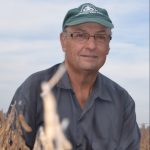Your financial gift to PFI will bring us closer to our vision of resilience. Please give today!
Cover Crop Field Day – Osage
Tuesday, April 2 | Osage, Iowa | 4 – 7 p.m.
Hosted by: Wayne Fredericks
Starting Location: We will start at the cover crop trial field, located less than 0.5 mile west of Hickory Avenue on the north side of IA Hwy 9.
Second Location: We will move next to a heated shop at the home farm, located at 1700 350th St. near Osage.
Event Description:
Get a first-hand view of the Fredericks’ ongoing cereal rye seeding rate and date trial. Wayne will also discuss his cover crop playbook, including planning preferences and termination methods. We’ll start in the field to view some cover crops before moving indoors for further discussion and a meal.
Topics:
- Seeding date and rate trial
About Wayne:
 Wayne and his wife, Ruth, farm in Mitchell County, just southwest of Osage, Iowa. They raise corn and soybeans on 756 acres in a 50-50 rotation, and have been long-time users of no-till and strip-till. More recently, they have added cover crops to the operation. The Fredericks have a passion for conservation and working to build healthy, productive soil, and they have worked for years with Iowa Soybean Association’s On-Farm Network conducting on-farm research, and with ISA’s Environmental Programs and Services to implement environmental practices on their farm. More recently, Wayne and Ruth have conducted cover crop trials with Practical Farmers of Iowa.
Wayne and his wife, Ruth, farm in Mitchell County, just southwest of Osage, Iowa. They raise corn and soybeans on 756 acres in a 50-50 rotation, and have been long-time users of no-till and strip-till. More recently, they have added cover crops to the operation. The Fredericks have a passion for conservation and working to build healthy, productive soil, and they have worked for years with Iowa Soybean Association’s On-Farm Network conducting on-farm research, and with ISA’s Environmental Programs and Services to implement environmental practices on their farm. More recently, Wayne and Ruth have conducted cover crop trials with Practical Farmers of Iowa.
“To us, it is about finding what productive, profitable, sustainable crop production practices work while keeping soil, water and air quality at the forefront,” Wayne says. “It is that balance that will help improve our competitiveness as producers.”
Wayne is a past president of ISA, currently serves on the board of directors of the American Soybean Association and also represents ASA on the Monarch Collaborative.
Meal information:
A meal will be catered by S&S Locker
This material is based upon work supported by the Natural Resources Conservation Service, U.S. Department of Agriculture, under number NR186114XXXXG003. Any opinions, findings, conclusions, or recommendations expressed in this publication are those of the author(s) and do not necessarily reflect the views of the U.S. Department of Agriculture. USDA is an equal opportunity provider and employer.
